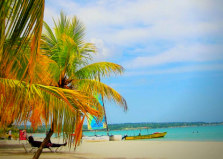
Source: Jamaicans.com-https://jamaicans.com/13-things-to-know-about-the-jamaican-national-costume/
The Jamaican National Costume has a long history that dates back to the island’s colonial period. Once commonly worn by 18th-century working women in Britain, the traditional ensemble is now primarily symbolic and ceremonial. Jamaican author, poet, and Jamaican folk ambassador, Miss Lou, (Louise Bennett) is pictured in full Jamaican National Costume on the cover of her book, Jamaica Labrish.
1. The costume’s design is attributed to Beth Lenworth Forbes in the country’s St. Ann District and was created in 1953.
2. The Jamaican National Costume consists of a fully-flared skirt made of bandana cloth. It’s a predominantly red fabric interwoven with white and blue to create a plaid pattern.
3. The dress, or skirt and blouse combination, was originally of cotton fabric woven in the Madras region of India and referred to as Madras bandana. In Jamaica, the material is simply called bandana. It’s a Sanskrit word (bandhna) that means tying, with the same meaning in Urdu.
4. The dress is worn over a white cotton petticoat that usually has a flounce or lace trim on the bottom. The skirt is traditionally held up on both hips, exposing the petticoat, and held in place by ribbons or clips. It’s reminiscent of the way women would hike up their skirts while working in the fields.
5. The bespoke ensemble typically features a square neck and a fitted bodice highlighted by short, puffy sleeves. The top portion is worn with a white blouse edged with matching bandana, but can also be a blouse to match the skirt rather than a single garment.
6. Many women now utilize a polyester cotton blend fabric that’s locally made instead of cotton.
All Posts7. A head tie completes the ensemble. The traditional head covering has deep roots and harks back to Africa. Jamaicans adapted it for working in the fields and the number of peaks in the back of the head tie was developed to differentiate the marital status of women among the enslaved population. A straw hat decorated with flowers is also an acceptable head covering.
8. Shoes were called wompers and made of grass and leaves. They were later made of materials that washed up on the beach. This type of foot covering was worn by men and women.
9. A man’s traditional attire consists of loose white pants that are rolled up to the knees in the way they were worn while working in the fields.
10. Men’s shirts are plain and unadorned, with short sleeves or long sleeves that are rolled up.
11. A leather belt or piece of rope is used to hold the trousers up.
12. A wide-brimmed straw hat woven of dried Silver Palm leaves is worn.
13. A black jacket or light coat may also be worn, along with a headdress for special occasions.

